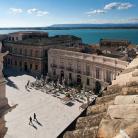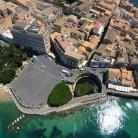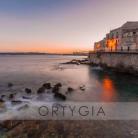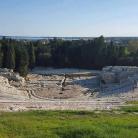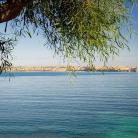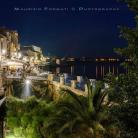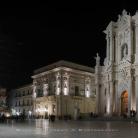Per informazioni:
Web: richiesta di prenotazione
Tel: (+0) 39 0931 880055
Cell:(+0) 39 3476863950
e-mail: agrituristcasmene@virgilio.it
Syracuse
Syracuse (or Siracusa) was the most important city of Magna Graecia. It defeated the mighty Athens in 413 and was home to many a great Greek, including the inimitable Archimedes. At the height of its economic, political and military powers, the city had a population of 300,000 and, according to Cicero, was “the greatest Greek city and the most beautiful of them all”.
For those travelling to Sicily today, Siracusa is not to be missed. It is relatively easy to visit in a day, though obviously deserves rather more time. A visit can be split into two easy parts: one dedicated to the archaeological site, the other to the island of Ortygia.
The archaeological site
The archaeological site, situated in the northwest of the town, is home to a staggering number of well-preserved Greek (and Roman) remains. The main attraction is undoubtedly the Greek theatre that dates back at least until the 5th Century BC. Its cavea is amongst the largest ever built: its 59 rows could accommodate up to 15,000 spectators. The theatre is still used for an annual Greek theatre festival running from the middle of May to the end of June.
Just over the ridge from the theatre are the old stone quarries (latomie). While today there is a delightful, fragrant lemon orchard, they used to serve a different, more sinister purpose: 7,000 Athenian prisoners of war were kept here after the Sicilian Expedition in 413. Of most interest is the famous “Ear of Dionysius”, a 20m-high, slender pointed arch cut into the rock face that develops inwards for about 65m. The name was given by Caravaggio during his visit in 1608 and legend would tell us that it was used by Dionysius the Tyrant as a prison for his bitterest enemies. The excellent Cathedral-like acoustics meant that he could hear their conversations from outside.
The Roman amphitheatre, built in the 3rd Century AD, is also very impressive. 140m long, it is one of the largest to be found anywhere. Its function was far removed from the Greek version. Here, traditional circus fare was offered, with gladiators and wild animals providing spectacles of blood-curdling violence. In the centre is rectangular hole that is thought to have had one of two purposes: a space for scenic machinery or a drain for the blood and gore!
The Archaeological Museum is just a stone’s throw from the archaeological park (in Via Teocrito) and contains a great collection of exhibits from all over the Syracuse area.
Ortigia - Syracuse's island heart
The best way to see the island of Ortygia is just to wander. It’s difficult to get lost (it measures just 1km by 500 metres), but packed with over 2,500 years of history. Architectural styles vary widely, encompassing Greek and Roman remains, Mediaeval Norman buildings and a great deal of (relatively) understated Baroque. Restaurants, trattorias and bars abound and it is especially nice to sit out on the western side in the late afternoon, warmed by the sun and with a view over the lagoon.
On crossing the bridge from the mainland you have three possibilities: turn right and walk along the western part, turn left towards the eastern part or go straight on into the centre.
The historical highlight of the western side is the fountain of Arethusa. Legend has it that Arethusa, originally an Arcadian nymph, fled underwater to Siracusa in an attempt to rid herself of the persistent amorous advances of the river God Alpheios. The Goddess Artemis transformed her into the fresh water spring that we can see today. All was in vain, however, as Alpheios located his prey and mixed his own waters with hers. Legend also has it that the spring is directly connected under the sea to the river at the sanctuary of Olympia.
Going straight on will take you first to the remains of the Temple of Apollo, which, being built in the 7th Century BC was supposedly the first great Doric temple of its kind in Sicily. Continuing up Corso Matteotti will bring you to Piazza Archimede, named after the town’s most famous son.
From here it is a short walk to the real centre of Ortygia, the Piazza del Duomo. This delightful pedestrian square is home to the wonderful Cathedral built on the site of an ancient Temple of Athena as can clearly be seen from the original Doric columns that were incorporated into the building’s main structure. Also on this square is the beautifully symmetrical Baroque Palazzo Beneventano and the church of Santa Lucia, the town’s patron saint.
Turning left at the entrance to the island will take you immediately to the colourful daily morning street market, which sells a fantastic array of fruit, vegetables, fish and meat. At the end of the market is a must-see for food lovers: a delicatessen of rare quality, called “I Sapori dei Gusti Smarriti” (literally the flavours of lost tastes). Here you can find cheeses, hams and cured meats of the very best quality, many of which, especially those produced in Sicily, you will find nowhere else. There is also an excellent assortment of wines, condiments, sun-dried tomatoes and other Sicilian delicacies made by the shop’s owners in their “laboratory”.
From here wandering around the eastern limits of Siracusa you fill find a maze of streets that eventually open out at the southern extreme of the island and the inaccessible Castello Maniace, a true bastion built by Frederick II in 1239.
Other sights of interest on Ortygia include the Byzantine Miqwe (Jewish baths) under the Hotel alla Giudecca.
However, as already mentioned at the beginning, the best way of visiting Ortygia is to simply follow your nose and soak up the atmosphere.

